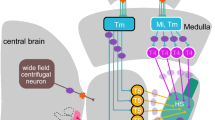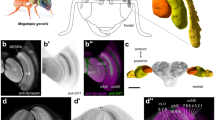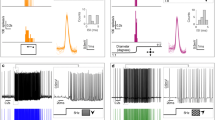Abstract
-
1.
The effects of the biogenic amines serotonin and octopamine on motion-sensitive neurons in the lobula of the honey bee were analysed electrophysiologically. Single cell activity was recorded intracellularly during application of amines. Field potentials in the lobula were recorded to measure the effects on populations of motion-sensitive neurons.
-
2.
Serotonin and octopamine modulate the response properties of motion-sensitive neurons in the lobula in a functionally antagonistic way.
-
3.
The application of serotonin, in most cases, reduces background activity as well as responses to moving stripe patterns by motion-sensitive lobula neurons. The direction specificity can also decrease after serotonin application. In accordance with the single cell recordings, the amplitudes of lobula field potentials evoked by moving stripe patterns are also reduced by application of serotonin.
-
4.
Octopamine leads to an increase in the amplitude and the initial slope of field potentials evoked by moving stripe patterns. However, there were no uniform effects at the single cell level after octopamine application.
-
5.
The modulatory effects of serotonin and octopamine on motion-sensitive neurons correlate well with some behavioral modifications elicited by these substances (Erber et al. 1991; Erber and Kloppenburg, companion paper).
Similar content being viewed by others
References
Bermudez I, Beadle DJ, Benson JA (1992) Multiple serotonin-activated currents in isolated, neuronal somata from locust thoracic ganglia. J Exp Biol 165:43–60
Claassen DE, Kammer AE (1986) Effects of octopamine, dopamine, and serotonin on production of flight motor output by thoracic ganglia of Manduca sexta. J Neurobiol 17:1–14
Davenport AP, Evans PD (1984a) Stress-induced changes in the octopamine levels of insect haemolymph. Insect Biochem 14:135–143
Davenport AP, Evans PD (1984b) Changes in haemolymph octopamine levels associated with food deprivation in the locust, Schistocerca gregaria. Physiol Entomol 9:269–274
Erber J, Kloppenburg P (1994) The modulatory effects of serotonin and octopamine in the visual system of the honeybee (Apis mellifera L.). I. Behavioral analysis of the motion-sensitive antennal reflex. J Comp Physiol A 176:111–118
Erber J, Homberg U, Gronenberg W (1987) Functional roles of the mushroom bodies in insects. In: Gupta AP (ed) Arthropod brain: its evolution, development, structure and functions. J Wiley, New York, pp 485–511
Erber J, Kloppenburg P, Scheidler A (1991) Neuromodulation in the honeybee: autoradiography, behaviour and electrophysiology. In: Goodman LJ, Fisher RC (eds) The behaviour and physiology of bees. CAB International Wallingford, pp 273–287
Evans PD (1980) Biogenic amines in the insect nervous system. Adv Insect Physiol 15:317–473
Evans PD (1985) Octopamine. In: Kerkut GA, Gilbert LI (eds) Comprehensive insect physiology, biochemistry and pharmacology, Vol 11. Pergamon, Oxford New York Toronto Sydney Paris Frankfurt, pp 499–530
Freeman JA, Nicholson C (1975) Experimental optimization of current source density technique for anuran cerebellum. J Neurophysiol 38:369–382
Fuchs E, Dustmann JH, Stadler H, Schürmann FW (1989) Neuroactive compounds in the brain of the honeybee during imaginal life. Comp Biochem Physiol 92C:337–342
Habets A, Lopes Da Silva FH, Mollevanger WJ (1980) An olfactory input to the hippocampus of the cat: field potential analysis. Brain Res 182:47–64
Harris-Warrick RM, Kravitz EA (1984) Cellular mechanisms for modulation of posture by octopamine and serotonin in the lobster. J Neurosci 4:1976–1993
Hertel H, Maronde U (1987) The physiology and morphology of centrally projecting visual interneurones in the honeybee brain. J Exp Biol 133:301–315
Hertel H, Schäfer S, Maronde U (1987) The physiology and morphology of visual comissures in the honeybee brain. J Exp Biol 133:283–300
Kaulen P (1982) Feldpotentiale und eine Analyse der Stromquellendichte in der Corpora Pedunculata von Apis mellifera. Diplomarbeit, Freie Universität Berlin
Kaulen P, Erber J, Mobbs P (1984) Current source density analysis in the mushroom bodies of the honeybee (Apis mellifera carnica). J Comp Physiol A 154:564–582
Kloppenburg P (1990) Neuroantomische Charakterisierung der antennalen Motoneuronen und elektrophysiologische Untersuchungen zur aminergen Modulation des visuellen Antennenreflexes der Honigbiene. Dissertation, Technische Universität Berlin, Fachbereich 14
Kravitz EA, Beltz B, Glusman S, Goy M, Harris-Warrick R, Johnston M, Livingstone M, Schwarz T, King Siwicki K (1985) The well-modulated lobster: The roles of serotonin, octopamine, and proctolin in the lobster nervous system. In: Selverston AI (ed) Model neural networks and behavior. Plenum Publ Corp, New York, pp 339–360
Kreissl S, Eichmüller S, Bicker G, Rapus J, Eckert M (1991) The distribution of octopamine-like immunoreactivity in the brain of the honeybee. In: Elsner N, Penzlin H (eds) Synapse — transmission — modulation. Thieme, Stuttgart New York, p 407
Lai-Wo Stan Leung (1979) Potentials evoked by alvear tract in hippocampal CA1 region of rats. II. Spatial field analysis. J Neurophysiol 42:1571–1589
Maronde U (1988) Strukturelle und funktionelle Charakterisierung visueller Interneuronenpopulationen im Protocerebrum der Honigbiene Apis mellifera. Dissertation, Freie Universität Berlin
Menzel R, Michelsen B, Rüffer P, Sugawa M (1988) Neuropharmacology of learning and memory in honey bees. In: Hertting G, Spatz H-C (eds) Modulation of synaptic transmission and plasticity in nervous systems. Springer, Berlin Heidelberg, pp 333–350
Mercer AR, Erber J (1983) The effects of amines on evoked potentials recorded in the mushroom bodies of the bee brain. J Comp Physiol 151:469–476
Mercer AR, Menzel R (1982) The effects of biogenic amines on conditioned and unconditioned responses to olfactory stimuli in the honeybee, Apis mellifera. J Comp Physiol 145:363–368
Mercer AR, Mobbs PG, Davenport AP, Evans PD (1983) Biogenic amines in the brain of the honeybee, Apis mellifera. Cell Tissue Res 243:655–677
Mitzdorf U, Singer W (1977) Laminar segregation of afferents to lateral geniculate nucleus of the cat: An analysis of current source density. J Neurophysiol 40:1227–1244
Nicholson C, Freeman J (1975) Theory of current source-density analysis and determination of conductivity tensor for anuran cerebellum. J Neurophysiol 38:356–368
Nicholson C, Llinas R (1975) Real time current source-density analysis using multielectrode array in cat cerebellum. Brain Res 100:418–424
Nunez PL (1981) Electric fields of the brain. Oxford Univ Press, New York, Oxford
O'Day PM, Lisman JE (1985) Octopamine enhances dark-adaptation in Limulus ventral photoreceptors. J Neurosci 5: 1490–1496
Pasztor VM, Bush BMH (1987) Peripheral modulation of mechano-sensitivity in primary afferent neurons. Nature 326:793–795
Pasztor VM, Bush BMH (1989) Primary afferent responses of a crustacean mechanoreceptor are modulated by proctolin, octopamine and serotonin. J Neurobiol 20:234–254
Ramirez J, Pearson KG (1991) Octopamine induces bursting and plateau potentials in insect neurones. Brain Res 549:332–337
Schäfer S (1984) Charakterisierung extrinsischer Großfeldneuronen aus der Medulla der Honigbiene (Apis mellifera). Diplomarbeit, Freie Universität Berlin
Scheidler A (1991) Autoradiographische Darstellung von Bindungsstellen für verschiedene Neurotransmitter-Kandidaten im Gehirn der Honigbiene (Apis mellifera L.) Dissertation, Technische Universität Berlin, Fachbereich 14
Scheidler A, Kaulen P, Brüning G, Erber J (1986) Autoradiographic localisation of octopamine and serotonin binding sites in the brain of the honeybee (Apis mellifera L.) Verh Dtsch Zool Ges 1986, p 293
Schürmann FW, Klemm N (1984) Serotonin-immunoreactive neurons in the brain of the honeybee. J Comp Neurol 225:570–580
Sombati S, Hoyle G (1984) Generation of specific behaviors in a locust by local release into neuropil of the natural neuromodulator octopamine. J Neurobiol 15:481–506
Stieve H, André E (1984) Octopamine modulates the sensitivity of Limulus ventral photoreceptor. Z Naturforsch 39C:981–985
Zimmerman RP (1978) Field potential analysis and the physiology of second-order neurons in the visual system of the fly. J Comp Physiol 126:297–316
Author information
Authors and Affiliations
Rights and permissions
About this article
Cite this article
Kloppenburg, P., Erber, J. The modulatory effects of serotonin and octopamine in the visual system of the honey bee (Apis mellifera L.). J Comp Physiol A 176, 119–129 (1995). https://doi.org/10.1007/BF00197758
Accepted:
Issue Date:
DOI: https://doi.org/10.1007/BF00197758




